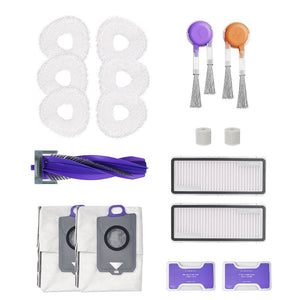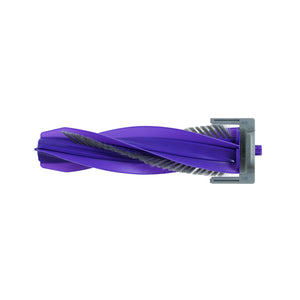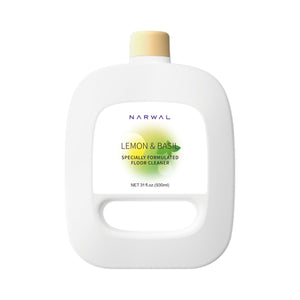Robotic vacuums are revolutionizing household cleaning. With little assistance from you, they accumulate dust and debris as they wander around your house.
Ever wondered how robot vacuums actually work? From moving around your home to cleaning under your couch, these smart devices combine sensors, maps, and suction power to get the job done with minimal input.
But how do these smart gadgets navigate and clean so efficiently? In this blog, we’ll dive into the fascinating technology behind robot vacuums, exploring their navigation systems, charging technologies, and smart features.
What is a Robot Vacuum?
A robot vacuum, or robovac, is an intelligent cleaning device designed to automate floor cleaning with minimal human intervention. Equipped with advanced sensors, AI algorithms, and navigation systems like LIDAR or visual mapping, it can efficiently clean various floor types, avoid obstacles, and reach tight spaces under furniture.
Modern robot vacuums offer smart features such as app control, customizable cleaning schedules, and voice assistant compatibility (e.g., Alexa, Google Assistant). High-end models even include self-emptying bases, where the device automatically empties its dustbin into a larger container, reducing maintenance for weeks.
The first commercial robot vacuum, the Trilobite by Electrolux, debuted in 1996, paving the way for today’s advanced models. Over the years, robot vacuums have evolved into essential smart home devices, combining convenience, efficiency, and cutting-edge technology to redefine home cleaning.
Quick Overview: How Robot Vacuums Work (Beginner-Friendly)
At a glance, robot vacuums seem simple—they move, clean, and return to their dock. But behind the scenes, they combine sensors, brushes, and smart navigation to do the job right.
Here’s what happens in plain terms:
-
They drive around your home using wheels and motors.
-
Brushes sweep dirt toward a suction system that collects debris.
-
Sensors help them dodge furniture, avoid stairs, and stay on track.
-
When their battery runs low, they recharge themselves—no help needed.
It’s smart, hands-free cleaning that feels almost magical.
How Does a Robot Vacuum Work? A Comprehensive Overview
A robot vacuum is an intelligent cleaning device that integrates advanced technologies to automate floor cleaning. By combining navigation systems, cleaning mechanisms, sensors, and smart connectivity, it delivers efficient and hands-free cleaning. Here’s a detailed breakdown of its working principles:
Navigation and Mapping System
The navigation system is the brain of the robot vacuum, enabling it to perceive and navigate its environment:
-
LIDAR (Light Detection and Ranging): Uses laser beams to create a 360-degree map of the room for precise navigation.
-
Visual Navigation: Cameras and AI algorithms identify objects, walls, and floor types.
-
Gyroscope and Accelerometer: Track the robot’s movement and orientation for accurate positioning.
How Do Robot Vacuums Know Where to Go?
Robot vacuums use sensors, cameras, or LiDAR to scan their surroundings and map your home. This map helps them track their position, avoid obstacles, and follow efficient cleaning routes—so they always know where they’ve been and where they need to go next.
Cleaning Mechanism
The cleaning system is the core functionality of the robot vacuum—it defines how robot vacuums clean your floors efficiently and autonomously. Here's how the cleaning process works:
-
Main Brush (Roller Brush): Loosens and lifts dirt from floors, especially effective on carpets.
-
Side Brushes: Sweep dust and debris from edges and corners into the suction path.
-
Suction Motor: Generates powerful airflow to collect dirt and debris into the dustbin.
-
Mopping Module (Optional): Uses a water tank and mop pad to clean hard floors, with some models featuring vibrating or rotating mop heads for deeper cleaning.
Together, these components illustrate how robot vacuums clean various surfaces with precision and minimal human input.
Sensor System
Sensors ensure safe and efficient operation:
-
Obstacle Detection Sensors: Detect objects like furniture and cords, allowing the robot to navigate around them.
-
Cliff Sensors: Prevent falls by detecting sudden drops, such as stairs.
-
Dirt Sensors: Identify high-traffic or particularly dirty areas for focused cleaning.
-
Collision Sensors: Detect collisions and adjust the robot’s direction.
Battery and Charging System
The power system supports autonomous operation:
-
Rechargeable Lithium-ion Battery: Provides long-lasting power for extended cleaning sessions.
-
Automatic Charging Dock: The robot returns to the dock to recharge when the battery is low and resumes cleaning after recharging.
-
Fast Charging Technology: Reduces charging time for improved efficiency.
Dust Collection and Filtration System
The dust collection system ensures effective cleaning and air quality:
-
Dustbin: Stores collected dirt and debris.
-
HEPA Filter: Captures fine particles to prevent allergens and dust from being released back into the air.
-
Self-Emptying Dock (Optional): Automatically empties the dustbin into a larger bag, reducing maintenance for weeks.
Smart Control System
Smart connectivity enhances user convenience and plays a key role in how robot vacuums work effectively in daily life. These control systems enable hands-free operation, personalized cleaning, and improved efficiency. Here's how:
-
Mobile App: Allows users to schedule cleanings, monitor progress, and customize settings remotely.
-
Voice Assistant Compatibility: Supports voice control via platforms like Alexa, Google Assistant, or Siri.
-
AI Algorithms: Optimize cleaning routes, adapt to environmental changes, and learn user preferences over time.
These features demonstrate how control systems help robot vacuums work smarter, not harder—delivering a seamless, automated cleaning experience tailored to your needs.
Body Design and Structure
The design ensures versatility and durability:
-
Compact and Low-Profile Body: Enables cleaning under furniture and in tight spaces.
-
Anti-Tangle Design: Prevents hair and fibers from clogging the brushes.
-
Waterproof Components: Protects internal electronics for safe mopping operations.
Advanced Features in Modern Robot Vacuums
Today’s robot vacuums go far beyond basic cleaning. Packed with smart enhancements and automation features, they showcase how advanced technology makes robot vacuums even more powerful and convenient.
Here are some cutting-edge features you’ll find in high-end models:
-
Self-Emptying Dock: Automatically transfers dust from the vacuum’s onboard bin into a sealed bag in the base station, reducing the need for frequent emptying.
-
Automatic Mop Cleaning: Some models can wash and dry the mop pad after each use—keeping the device clean and ready with zero effort.
-
UV Sterilization: Uses ultraviolet light to disinfect hard floors while cleaning, targeting bacteria and allergens.
-
Auto Water Refill: Maintains mopping performance by refilling the water tank during cleaning cycles.
-
Custom App Zones: Lets you set room-specific preferences (e.g., stronger suction in the kitchen, mopping off in carpeted areas).
-
3D Object Recognition: Uses AI-powered vision systems to avoid small objects like cords, pet bowls, or socks.
These features highlight just how far robot vacuums have come—from simple dust sweepers to smart home assistants capable of personalized, hygienic, and efficient floor care.
How Do Robot Vacuums Navigate and Map Your Home?

Robot vacuums use advanced navigation technologies to map and navigate your home, ensuring thorough and efficient cleaning. These technologies include sensor-based navigation, camera-based navigation, and LiDAR technology. Here’s a detailed look at how they work:
Sensor-Based Navigation
Sensor-based navigation relies on various sensors to detect obstacles, measure distances, and prevent falls. Common sensors include:
-
Infrared Sensors: Emit infrared light and measure its reflection to detect obstacles. When the robot encounters an obstacle, it changes direction to avoid a collision.
-
Ultrasonic Sensors: Send out ultrasonic waves and measure the time it takes for them to return after striking an object. This helps the vacuum gauge distance and navigate around obstacles more effectively.
-
Cliff Sensors: Detect changes in floor height and stop the vacuum from moving forward if a drop is detected, preventing falls.
Camera-Based Navigation
Camera-based navigation uses cameras to capture images of the environment, which the robot vacuum processes to map and navigate your home.
-
Dynamic Adaptation: Adapts to changes in the environment, such as moving furniture or new obstacles.
-
Limitations: Less effective in low-light conditions, as the cameras rely on visible light to capture images.
A standout example of camera-based navigation is the Narwal Freo Z Ultra. Equipped with high-resolution cameras and advanced AI algorithms, the Freo Z Ultra captures detailed images of your home, creating a precise visual map. This allows it to navigate complex layouts with ease and adapt to changes in real time. Additionally, its AI-powered object recognition can identify common household items like shoes, cables, and pet toys, ensuring a more efficient and obstacle-free cleaning experience.
[cta:narwal-freo-z-ultra-robot-vacuum-mop]
LiDAR Technology
LiDAR (Light Detection and Ranging) uses laser beams to create precise maps of the cleaning area.
-
How It Works: Emits laser beams that bounce off objects and return to the sensor. By measuring the time it takes for the beams to return, the vacuum can create an accurate, detailed map of its surroundings.
-
Advantages: Works well in all lighting conditions and navigates complex environments with high accuracy.
An excellent example of a robot vacuum that uses advanced LiDAR technology is the Narwal Freo X Ultra. With its LiDAR 4.0 Navigation, it can scan 360 degrees of your house to determine and follow the best cleaning route, ensuring every corner is covered efficiently.
Multi-Sensor Fusion Technology
Many high-end robot vacuums combine multiple sensors (e.g., LiDAR, cameras, and infrared) to enhance navigation accuracy and adaptability. This approach compensates for the limitations of individual sensors, providing a more reliable cleaning experience.
Smart Features for Enhanced User Experience
-
Virtual Walls and No-Go Zones: Users can set virtual boundaries via a mobile app to restrict the robot’s movement.
-
Room Recognition and Zoned Cleaning: The robot can identify different rooms and clean specific areas as needed.
-
Voice Control and Smart Home Integration: Compatible with voice assistants like Alexa and Google Assistant for hands-free control.
Future Trends in Robot Vacuum Navigation
-
AI and Machine Learning: Robots will learn user habits and optimize cleaning paths over time.
-
3D Mapping and Object Recognition: Future models may support 3D mapping and more detailed object recognition.
-
Stair-Climbing Capabilities: Prototypes like the Ascender are being developed to clean stairs.
From sensor-based navigation to advanced LiDAR and camera-based systems, robot vacuums have come a long way in delivering efficient and intelligent cleaning. Products like the Narwal Freo Z Ultra and Freo X Ultra showcase the cutting-edge technologies that make these devices indispensable in modern homes. As technology continues to evolve, robot vacuums will become even smarter, more adaptable, and more integrated into our daily lives, making home cleaning easier than ever before.
[cta:narwal-freo-x-ultra-robot-vacuum-mop]
What Are the Battery and Charging Technologies?

Robot vacuums utilize advanced battery and charging technologies to ensure they can clean your home efficiently without constant manual intervention. These technologies include various types of batteries with different capacities and smart charging systems that enable features like auto-docking and quick charging.
Battery Types and Capacities
Robot vacuums primarily use Lithium-ion (Li-ion) batteries because they have higher energy density, longer lifespan, and are lighter. These batteries provide consistent power, making them ideal for extended cleaning sessions.
Nickel-metal hydride (NiMH) batteries are less common, heavier, and have a shorter lifespan compared to Li-ion batteries. However, they are more environmentally friendly and less prone to overheating.
Smart Charging and Auto-Docking
Smart charging systems are essential for maintaining the efficiency and convenience of robot vacuums. These systems include features like auto-docking and quick charging.
- Auto-Docking: When the battery is nearly drained, this feature allows the robot vacuum to automatically navigate back to its charging dock. Upon reaching full charge, several models have the ability to continue cleaning automatically, guaranteeing uninterrupted cleaning without the need for user assistance.
- Quick Charging: A few more advanced models have fast charging capabilities that shorten the time it takes to fully recharge the battery. This is especially helpful for homes that need to be cleaned frequently.
Smart charging systems enhance the user experience by minimizing downtime and ensuring the vacuum is always ready for the next cleaning. For instance, the Narwal Freo X Plus is equipped with an intelligent charging system that optimizes the charging process. This system allows the vacuum to clean for up to 254 minutes and quickly return to cleaning after a short charge.
What Are the Smart Features and Connectivity Options?

Modern robot vacuums are equipped with a variety of smart features that enhance convenience, efficiency, and user control. These features make cleaning effortless and tailored to individual needs. Here’s a detailed look at the key smart functionalities:
Remote Control and Mobile App Integration
Robot vacuums come with intuitive interfaces that allow users to control them remotely via buttons or a mobile app.
-
Remote Operation: Start, stop, or schedule cleaning sessions with just a few taps on your smartphone, even when you’re away from home.
-
Customization: Advanced models let you customize cleaning routes, set no-go zones, or focus on specific areas for targeted cleaning.
-
Real-Time Monitoring: Check the vacuum’s status, such as battery level, cleaning progress, and error notifications, in real time.
For example, the Narwal app provides seamless control over the cleaning process, allowing users to personalize their cleaning experience with zero hassle.
Voice Control Integration
Voice control integration enables hands-free operation through smart home systems like Amazon Alexa, Google Assistant, and Apple Siri.
-
Simple Commands: Use voice commands like “Alexa, start cleaning” or “Hey Siri, vacuum the living room” to control your robot vacuum.
-
Accessibility: This feature is particularly beneficial for the elderly, people with disabilities, or those who prefer not to use the app.
With the Narwal system, you can simply ask your voice assistant to start cleaning, ensuring your home is taken care of without any effort on your part.
Scheduling and Customization
Scheduling and customization features promote automatic cleaning tailored to your lifestyle.
-
Preset Schedules: Set cleaning schedules based on the time of day or specific days of the week. For example, schedule the vacuum to clean every morning at 10 AM.
-
Smart Triggers: Integrate with smart home systems to set triggers, such as starting the vacuum when you leave home or turning on lights when cleaning begins.
-
Room-Specific Settings: Customize cleaning modes (e.g., suction power, water flow) for different rooms to optimize performance.
Self-Emptying Function
The self-emptying function is a game-changer for robot vacuums, significantly reducing maintenance and enhancing convenience.
-
How It Works: After completing a cleaning session, the robot returns to its docking station, where a built-in system automatically empties the dustbin into a larger sealed bag.
-
Benefits:
-
Reduces the need for frequent dustbin emptying, especially in homes with pets or high dust levels.
-
Keeps the vacuum ready for the next cleaning session without manual intervention.
-
Minimizes exposure to dust and allergens, improving indoor air quality.
For example, the Narwal Freo X Ultra features an advanced self-emptying system that can store up to 7 weeks of dust, making it an ideal choice for busy households.
Advanced Cleaning and Maintenance Features
Some high-end robot vacuums offer additional cleaning and maintenance features:
-
Automatic Mop Cleaning: Washes and dries the mop pad after use, ensuring hygiene and convenience.
-
Auto-Refill Water Tank: Refills the water tank during cleaning for uninterrupted mopping.
-
UV Sterilization: Uses ultraviolet light to disinfect floors during cleaning.
From remote control and voice commands to self-emptying and advanced cleaning features, modern robot vacuums are designed to make home cleaning effortless and efficient. Products like the Narwal Freo X Ultra and Freo Z Ultra showcase these smart functionalities, offering users a truly intelligent and hassle-free cleaning experience. As technology continues to evolve, robot vacuums will become even more integrated into our daily lives, redefining the way we maintain our homes.
Artificial Intelligence and Machine Learning
Artificial intelligence (AI) and machine learning (ML) technologies significantly improve the performance and efficiency of robot vacuums. AI enables the vacuum to learn the layout of the home and adapt its cleaning path for maximum efficiency. Machine learning helps the vacuum recognize and avoid obstacles more effectively, reducing the chances of getting stuck. Over time, the vacuum's performance improves as it learns from previous cleaning sessions, ensuring more thorough and efficient cleaning.

Getting Started with Your Robot Vacuum: A Simple Setup Guide
Setting up a robot vacuum is quick and easy. Follow these steps to get started:
-
Charge the Vacuum: Fully charge the robot before first use to ensure optimal performance.
-
Download the App: Install the companion app on your smartphone or tablet.
-
Connect to Wi-Fi: Link the robot to your Wi-Fi network to enable app control and automatic updates.
-
Map Your Home: Let the robot scan and map your space. Avoid moving it during this process to ensure accurate mapping.
-
Set a Cleaning Schedule: Customize cleaning schedules based on your preferences, whether daily, weekly, or for specific areas.
With these steps, your robot vacuum will be ready to keep your home spotless with minimal effort.
Finding the Perfect Robot Vacuum: A Buyer’s Guide
Choosing the right robot vacuum depends on your specific needs. Here are key factors to consider:
-
Budget: Determine how much you’re willing to spend. Higher-priced models often offer advanced features like self-emptying and AI navigation.
-
Home Size and Layout: For larger homes or multi-floor setups, choose a robot with multi-floor mapping and long battery life.
-
Noise Level: If you need a quiet environment, opt for models with noise levels below 70 dB.
-
Cleaning Performance: Look for strong suction power, efficient mopping systems, and advanced navigation for thorough cleaning.
-
Special Needs: If you have pets or children, prioritize models with obstacle avoidance and anti-tangle brushes.
By considering these factors, you can find a robot vacuum that perfectly suits your lifestyle and cleaning needs.
Conclusion
Robot vacuums revolutionize cleaning with advanced navigation, smart charging, and convenient app and voice controls. AI and machine learning continuously enhance their performance, adapting to your home's needs. Understanding these technologies helps you choose the best vacuum for effortless cleaning.
FAQs
What AI technologies does a robot vacuum use?
Robot vacuums use artificial intelligence (AI) technologies like machine learning and computer vision. Machine learning allows them to adapt to their environment, optimizing cleaning patterns based on previous sessions. Computer vision helps the vacuum recognize and avoid obstacles more effectively.
How does a robot vacuum know where to clean?
Robot vacuums use advanced navigation technologies such as LiDAR, cameras, and various sensors (infrared, ultrasonic, and cliff sensors) to map and navigate your home. These technologies enable the vacuum to create a detailed map of the area and plan efficient cleaning paths, ensuring thorough coverage without missing spots.
How does a robot vacuum find its base?
Robot vacuums find their base using sensors and mapping technologies. When the battery is low or cleaning is complete, the vacuum uses infrared or radio signals emitted by the base station to navigate back. Some models also use the detailed map created during cleaning to find the most efficient route back to the base.





















































